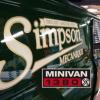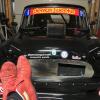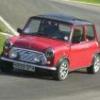
Bump Steer, And Identifying Mini Vs Metro Hubs Please ?
#31

Posted 13 October 2015 - 11:44 PM
Not many people have published any info.
Info can be found in regards to the use of Mini hubs in other applications. But rarely utilising the Mini suspension.
There are a number of people who have had their cars "looked at" and info noted but they tend to be of the lowered/race version.
But most of this was recorded pre computers and PDFs files.
When I was looking for info 15/16 years ago there was little. And had to make my own measurements. I was luck to have access to some kit to accuratelyish measure the hub pivots.
But it is still seen as one of the black arts through a number of things. The cost of the kit to make the measurements. And then the interpretation of the numbers.
#32

Posted 14 October 2015 - 12:09 AM
Have you also checked the Bump Steer since altering it, through a few steering angles?
I had some spare time a few days ago and did a little further analysis of the stock front end set up.
Yes - on paper - it has bump steer and the MKII more so than the MKI set up (I found reference to a MKIII set up - anyone know anything on that? I haven't had time to look through my stuff).
But,,,,,
It is done to introduce Roll Steer. If you have a look at Rory's plots on the previous page, at the 'as found' curve, you'll see that as we get 'Droop' we get Toe Out and as we get 'Bump', we also get Toe In.
What happens when we corner (talking standard Cars here)? We get Body Roll.
What happens to the inside wheel when we get Body Roll? It 'Droops' and in doing so, gives more 'Turn In'.
What happens to the outside wheel when we get Body Roll? It 'Bumps' and in doing so, gives more 'Turn In'.
I've got my own ideas on what this will do for handling and feel, but rather than speculate, I'd rather hear back from Rory once he gets a chance to drive it.
#33

Posted 14 October 2015 - 07:47 PM
And the good old understeer.
#34

Posted 10 December 2015 - 02:36 PM
Result :
A million-fold improvement in handling, straight-line stability, with no reduction in nippiness or feed-back.
I ran the mods and measurements past a much-published Mini professional, one of the rare ones who actually understands some physics and engineering, and this was his reply :
Your system to sort out your bump steer is quite damned impressive .............. the aim for any self respecting car is no bump steer ............ certainly dampens down the 'active' feel of the front end of the car The Mini, as standard, has pretty poor bump steer outside a very narrow amount of bump and droop that develops in to the spawn of the devil once the car is lowered a significant amount. Hence all the seriously nasty directional instability when exacerbating the lowered stance waywardness with stupidly wide 13-inch diameter wheels and associated tyres. Amplified by those fitting a much smaller diameter steering wheel. Madness.Interesting illustration of the before and after adjusted steering arms, and why I machine the top surface of the steering arm around the original track rod taper pin hole and use bolts/rod ends with the joint sited above the arm. I am as impressed as hell with the steering am adjustment rig! Big respect for that!
I am now convinced that many of the tributes to the Mini's twitchy steering are actually reflections of the fact that there are a VAST number of cars out there with massive bump-steer, driven by people who are completely oblivious to it since setting the tracking at ride-height is as far as they get.
If anyone wants to decry this conclusion, would they first of all measure (accurately) and publish their own bump-droop plot curves.
There would be no such thing as a one-size-fits-all fix unfortunately, since the accumulation of chassis tolerances and variations in rack positions would mean that no two cars are alike.
 DSC09941.JPG 86.15K
28 downloads
DSC09941.JPG 86.15K
28 downloads
Here are the details of the components I used from McGill in Fife if anyone wants to have a go themselves.
 DSC09942.JPG 40.24K
30 downloads
DSC09942.JPG 40.24K
30 downloads
Kind regards to all,
Rory
PS and here are some ideas for fitting the boots, which are a deliberately tight fit.
 DSC09943.JPG 31.55K
8 downloads
DSC09943.JPG 31.55K
8 downloads
 DSC09944.JPG 27.36K
10 downloads
DSC09944.JPG 27.36K
10 downloads
 DSC09945.JPG 32.24K
7 downloads
DSC09945.JPG 32.24K
7 downloads
Edited by MontpellierVanMan, 10 December 2015 - 02:40 PM.
#35

Posted 25 September 2016 - 08:57 PM
Bit of a thread revival on Rory 'Monty's' excellent work here.
I've spent a little more time on analysis of this issue of Bump Steer in Minis. I've mentioned before that while I am aware of this problem, that I haven't found it particularly noticeable. The reason for this is our Minis (and nearly all our Mokes) retained MKI Steering right to the end. Further detailed analysis of MKI Steering actually shows that while the problem is there, it's not huge and this is why I've made the observation that I hardly notice it.
However, MKII Steering is quite a different kettle of fish.
The MKII Steering was introduced in the UK I think around 1967- 1968-ish and was done to make the turning circle of the Mini smaller. As part of that re-design they increased the Ackerman Angle of the Steering Arms and it's primarily from this that the dramatic increase in Bump Steer, that Rory measured, comes from. This is also why I've noticed it when MKII Steering Arms are fitted. On something with a longer wheel base, like the Van and Pick up, this becomes yet worse again, though probably only academically so.
The Ackerman Angle for those who don't know what it is is part of the steering geometry design to make the Inside Wheel turn tighter than the Outside Wheel when steering around a corner. For most road going turns, this isn't an issue, it's more tighter carpark type turns when this does become an issue.
To correct it, while I can't see that it can be 100% corrected it's necessary, as Rory found' to raise the centre of the Steering Rod End. Roy did this by essentially bending the arms, but in a specialised way and not really one for most of us to try on.
Another way is to add shims under the Steering Arm where they bolt on to the Hub. I'm still in the deep throws of properly analysing this issue, but initial indications are that the MKII Steering Arm needs raising by 2.81 mm. This however may make the dowels between the Arm and the Hub too short, so they may also need replacing with longer ones. Food for thought.
<Edit: I also have re-newed and a much high respect for some of the original design guys like Jack Daniel and Co. What they did with little more than a drawing table and a slide rule is incredible. >
Edited by Moke Spider, 25 September 2016 - 09:02 PM.
#36

Posted 25 September 2016 - 09:46 PM
It came down to the parts makers to represent these in the metal.
And most of us have (had) to use some expensive kit to measure the points. And now we are relying on the current parts makers to keep on making the parts to the same design.
Just thinking on your lifting of the steering arm.
Yes new dowels. But what about re machining the taper in the arm?
#37

Posted 25 September 2016 - 09:55 PM
Just thinking on your lifting of the steering arm.
Yes new dowels. But what about re machining the taper in the arm?
I think you'd run out of Diameter of the tapered Pin / Thread of the Steering Rod End. The end of that thread is only about 0.5 - 1.0 mm below the the flat for the nut.
I think I'd prefer to fit shims between the arm and hub as it's adjustable for the very reasons you've mention - getting all the bits from paper to metal - accurately.
#38

Posted 25 September 2016 - 09:59 PM
#39

Posted 25 September 2016 - 11:36 PM
Ahh yes standard arms. I was thinking the thicker S type ones as there is more material?
Even on the S Arms, the very end where the Steering Rod End goes through is the same thickness as the lesser models.
#40

Posted 26 September 2016 - 08:15 AM
I miss read/understood the comment last night. got it now that I am awake. washer under the nut?
spacer under the arm is looking better.
#41

Posted 26 September 2016 - 08:15 AM
Excerpt from the ERA design report :
Steering/Drivability
Installation of the high power development engine into a prototype car with 13" wheels and Metro Turbo brakes but in otherwise standard suspension trim gave handling problems, in particular:-
i) Torque steer with the application of power.
ii) Bump steer.
iii) General "nervousness".
Geoscan Limited, a specialist competition suspension design company, ran a computer survey of the existing geometry and made a number of suggestions for modification. After extensive development, the following changes were made.
(i) Front suspension ride height lowered by c. 15 mm.
(ii) Front wheel toe out increased to 3/16".
(iii) Track rod end ball joints raised 10 mm by fitting 10 mm spacers under front steering arms.
(iv) Rear anti-roll bar fitted~
(v) Adjustable shock absorbers fitted on all four wheels.
(vi) Front lower suspension arms lengthened to provide 1-1.5 degrees negative camber.
(vii) To accommodate
(vi) Longer fitting ball joints fitted from steering rack ends to wheel steering arms.
The parts list suggests that the 10mm spacer was fabricated by ERA, and the longer steering rack track rods are the Triumph ones we generally fit anyway !!
I have seen this type of spacer before, and people like MondoSport have different looking steering arms available - probably to raise the steering arm in this fashion.
10mm is a far cry from your proposed 2.8mm Chris, but perhaps with the 13" wheels and 15mm drop in height it all works out in the end ??
Phil.
#42

Posted 26 September 2016 - 08:36 AM
Mondo and co tend to have the straight (flat) arms that are then used with a rose joint set up that can be spaced to suit.
now to the differences, and to the solutions. there will be many correct answers as it all depends on where your hub is in relation to the subframe and where your pivot points are on the subframe.
many (all) of the rose jointed tie bars move the pivot point rearwards in the car. changing the camber moves the bottom ball joint position which therefor moves the ideal point for the steering arm pivot.
then we should also thing about the differences between the LWB and SWB variants and how getting "correct" Ackerman effects the steering arm pivot point.
#43

Posted 26 September 2016 - 08:39 AM
10mm is a far cry from your proposed 2.8mm Chris, but perhaps with the 13" wheels and 15mm drop in height it all works out in the end ??
I'm still analysing it all and even today, yet found another item that has thrown all my work to date almost out the window!
The original King Pin Angle was 9.50, however it would seem at some point ??? this was changed to 8.520, so I know this will change my initial early number of 2.81 mm, which way, how much ??? dunno, but while it only looks like 1.020 change, it does have a huge knock on effect, though I'll say off hand, 10 mm does sound excessive and it maybe that they were looking to dial the bump steer back the other way. As it currently stands, the (standard) Mini on Roll Steer tries to turn harder in to the corner and I'm suspecting that the analysis and recommendations for the ERA may have been done to make the wheels steer slightly out on Roll Steer and that's usually considered safer for the 'average' driver as it give an impression of understeer, which would be much more of an issue on low profile 13" wheels.
Many thanks Phil for the info on the ERA.
<Edit: I think I've an ERA Parts listing, I'll see if I can lay my hands on it,,,,,,>
Edited by Moke Spider, 26 September 2016 - 08:44 AM.
#44

Posted 26 September 2016 - 08:47 AM
My bump-steer was SO far off that I wondered (still wondered ?) whether I hadn't just got the wrong hub-carriers.
Keen followers of the genre may remember that my original posting began with precisely that suggestion.
But unless I'm mistaken the only opportunity to fit the wrong parts comes from inadvertently using Metro hubs, and they're SO different regarding the ball-joint-swivel-pin assemblies that you can't get this wrong.
Which brings us to the conclusion that the post-68 or whatever MkII bump-steer really is appalling - but doesn't help us understand why they got it so wrong.
HOWEVER, the recent suggestions here about raising the steering arm and requiring longer dowels etc don't fit in with my own experience - remember that I raised my steering arms so that I could get the replacement rose-joint centres at the right height, which is not at all the same as shifting the position of Standard steering-rod ends.
My detailed conversations with people who might know (Glyn Swift, Keith Calver) threw up consistent suggestions that their practice was to machine a distance OFF the bottom of the steering-arms where they sit on the hub - effectively LOWERING them, NOT raising them.
One of them I think even proposed that this could also be done by milling the upright's seating and deepening the threads and dowel holes.
I won't quote a figure for this in case it become folk-lore.
I would suggest that any serious student takes 1/4" off the lower mounting face of a pair of steering arms (for measuring purposes only), which is probably too much, and then experiments with shims to adjust the height whilst measuring the effect on the bump-steer.
The LED pointer clamped to the disc and pointed at a distant surface is a ****-hot way of getting fast and accurate feedback regarding what is going on, and I'm surprised that nobody here has bitten the bullet to have ago themselves.
After all "I know Nothing ...... I am from Montpellier" (which is almost Barcelona, after all ........)
#45

Posted 26 September 2016 - 09:04 AM
Phil - The other item that throws a cat among it all on the ERA is they had a wider track due to the Vented Discs and off-set Drive Flange.
Rory - I'm only working 'on paper' at this time. While I've had a bit of a look at the MKII Steering, my focus is not on that set up as it doesn't suit our Big Wheel Mokes, but I was looking at 'cause and effect'. What I've seen and ERA also found, that the ball centre of the Steering Rod End does need to be raised, not lowered.
In regards to your question 'why they got it so wrong' - just my own thoughts here, but I think they knew the effect of what was done, but due to market pressures, chose to run with it. The 'quirk' of bump steer is so easily overlooked by the average driver and all too easily written off as being the bump, not the car, that caused it to dart on the road, but what they did hear was everyone's complaint that for a car so small, why has it got a turning circle bigger than a truck?
0 user(s) are reading this topic
0 members, 0 guests, 0 anonymous users
















